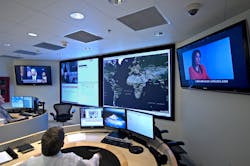The Impact of Central Monitoring Software
The role of today’s security manger continues to evolve. Leaders once tasked with managing security technology systems are now faced with an ever-expanding risk environment that includes physical security, crime, natural disasters, risk management and cyber threats.
This changing nature of security and risk drives organizations to build private command centers to gather intelligence, analyze data and evaluate threats. Organizations without the internal manpower and expertise to develop internal security operations centers look to partner with progressive security monitoring organizations that can act as an extension of its internal security team. Both options are valuable approaches that help today’s largest enterprise, public sector and government organizations realize new levels of situational awareness while achieving higher levels of operational efficiencies.
A security operations center is a critical component of any security and risk mitigation program, enabling rapid and effective response to a variety of risks or security situations. Additionally, these command centers help security leaders optimize communications and coordinate actions between multiple departments and first responders.
However, this can only occur if the technology systems in place designed to enhance security can be optimized to communicate and correlate critical data points in a unified manner.
Growing Market Need
The process of integrating data from disparate security devices and systems has been a challenge for integrators and end-users alike. To achieve the ideal level of awareness to ensure robust security practices that effectively mitigate risk, organizations require solutions that can consolidate multiple data points into a single solution. Physical Security Information Management (PSIM) was designed to serve as the central clearinghouse for communication between multiple platforms and edge devices, and present them as a unified interface to drive enhanced levels of awareness.
To date, PSIM platforms have often been difficult to deploy, administer and manage. These systems have been successful in addressing the needs of the public sector — especially in the critical infrastructure and transportation markets — where government money is often readily available, and long purchasing cycles and implementation times are commonplace. But these same platforms have struggled to address the needs of commercial businesses, large enterprises and educational facilities. Typical PSIM products have not been built to address the stringent needs of customers in these markets and therefore, successful deployments have been minimal.
Cloud-based command center software platforms are now available and enable organizations to broaden the scope and benefits of traditional systems while significantly increasing ROI and long-term investment protection. Often associated with private security operations centers, these same platforms are now being leveraged in the progressive central station market. Such solutions are designed to help central stations deliver video-based services to a varying customer base, build recurring revenue and complement existing investments. Cloud-based central station software has also dramatically increased the efficiency of monitoring stations offering next-generation video monitoring services.
Central stations face a significant challenge because they support a myriad of devices from a wide range of clients. To consistently support this growing range of devices and systems, these businesses require a software platform to help monitor current and future systems. Rapid deployment is also critical in this competitive market as customer demands frequently change.
The Benefits of the Software
Whether used in a private command center or a central station environment, enterprise command center software is designed from the ground up to focus on the major components critical to developing a robust security program. Its Web-based architecture enables users to customize it to the specific needs of their organization or their client. An open-platform design and support for a wide variety of third-party devices supports rapid deployment and minimizes expensive, complex piecemeal solutions.
At the same time, the operational design of these systems allows for the automation of manual processes to streamline the delivery of security services, eliminating the opportunity for operator error and nuisance alarms, ensuring only actual security events are handled. Additionally, the platform is scalable, reliable, secure and flexible, making it ideal for a variety of deployments.
To contribute to an organization’s overall success, security and business continuity, enterprise command center software must be able to work well with existing infrastructure, easily integrate with systems from multiple vendors, and provide a seamless and comprehensive picture of security processes. The integration of critical data into one common platform helps ensure that the most relevant risk information is provided to the leaders that need it most. More informed decisions lead to higher levels of safety and security.
Easing operator duties is also a key benefit when deploying enterprise command center software in any environment, but especially the central station market where high turnover can cause problems with operator training and reliability. Auto-handling functionality ensures operators are paying attention to the most critical security alerts and following best practices. Email alerts are automatically filtered to enable users to quickly determine which messages need immediate attention. If something does require attention, the system automatically pulls up any relevant security systems in the area of the alarm, such as surveillance cameras, and provides the operator with specific instructions on what steps to take next.
Training is also simplified because operators are only using a single, unified interface. The ability to add predetermined steps for operators to follow during various security events has also enabled users to become more efficient in performing their duties. Overall, a centralized approach simplifies the management of an organization’s entire security technology network and subsequently, eliminates the need to learn and become proficient with multiple platforms.
Applications
THRIVE Universal is an example of a central station that is taking advantage of cloud-based command center software. It has leveraged the investment to design a full suite of cutting-edge security services and execute the delivery of those services on a national level. The company’s end-to-end video surveillance solution and analytics software detect suspicious activity, send automated alerts and provide a path to intervene with real-time situational awareness intelligence. The company’s video SaaS solutions combine event-based video monitoring, edge-based analytics, managed security services and other alarm-monitoring services to provide an integrated set of security solutions.
THRIVE leverages SureView Systems Immix CS software to integrate with multiple video systems and process multiple events to enable response to incidents in a timely and effective manner. Immix is an advanced software platform for commercial central stations, enabling the delivery of a full suite of monitoring services, from video verification to complex interactive video monitoring, as well as other event-management services. It integrates with more than 500 security and alert devices to bring together different types of systems and devices and allow them to be managed in a single, easy-to-use operator interface.
On the private command center side, the San Francisco Metropolitan Transportation Agency (SFMTA) built a new command center called the Transportation Management Center (TMC) in the heart of San Francisco to centralize the response and coordination of its security and response teams. In this new collaborative command center, SFMTA deployed a centralized command center software platform to provide a single interface for the different security teams in traffic and transit to access its six different cameras and video systems.
With the right technology, enhanced awareness and centralized system management, organizations of all kinds can build a responsive and proactive approach to security that drives enhanced response now and into the future.
Rob Hile is Director of Enterprise Command Centers for SureView Systems. To request more info about the company, visit www.securityinfowatch.com/10486857.




